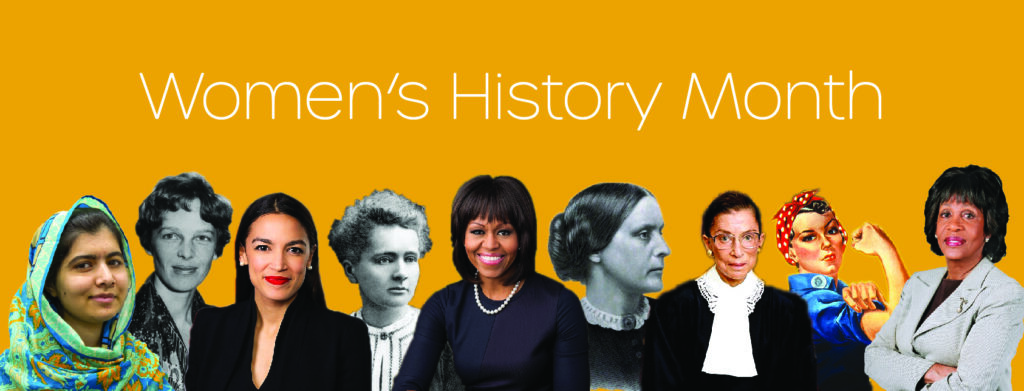
National Women’s History Month: Celebrating the Past & Fighting for the Future
Read Maddie’s piece about National Women’s History Month and why it is important for all.
March is National Women’s History Month. There are many reasons to celebrate and acknowledge this important month; to celebrate the women before us, recognize the amazing female achievements that have led up to today, and to support the women of the present day, who will make history in the future. The other important purpose of this month is to advocate and talk about issues that are occurring today for females, preventing them from shattering that glass ceiling. The purpose of my article is to spread awareness and talk about an issue I don’t hear enough about, which is gender inequality in the workplace. This is something I feel super passionate about. I want to bring my perspective and help everyone really understand how important it is to change what’s going on.
The gender gap problem began in the Paleolithic era when the egalitarian lifestyle was scrapped and the two genders began to take on different responsibilities. Women took care of children and household chores such as cooking while men took care of hunting and fishing. You may be wondering why I pointed this out. It’s because that was roughly 2.5 million years ago when life was last equal between the two genders. It’s crazy to think about how many challenges and barriers us women have faced over the course of time leading up to today.
As time went on, these roles became the new norm. Stereotypes were becoming engraved into the history of not only the US, but the entire world. In movies and TV shows women were portrayed as housewives and there to provide comfort for their husband and children. If they had a job at all it would’ve been as a man’s secretary, a nurse, housekeeper, or teacher. These are all what I refer to as nurturing jobs. Due to how common it was to have women perform these jobs, men took on all of the office, STEM, and business jobs. It became so incredibly unlikely to see females in these positions, it grew nearly impossible to be taken seriously as a woman who wanted to achieve one of those jobs. Over time of course, we have achieved the ability of working side by side with men in all of these positions. However, the numbers prove that the ratio of men to women is still very uneven.
The unequal numbers are due to the lack of exposure at a young age and lack of representation to begin with. Even though it is achievable, such small numbers of women can get to these high-level jobs. That is due to not being taken seriously by male superiors and coworkers. Not enough women are in these high-ranked positions, which causes a ripple effect for future generations. We need to expose girls to the fact that they can go into these positions even if they don’t see many women in those spots.
Over (the first) quarantine in the spring, I set out to do research for a class project concerning this issue. As part of my research, I got in contact (via zoom) with four successful women who currently or formerly work at HSBC bank, that could tell me their experiences with gender discrimination and lack of STEM exposure. Paula Ferguson; HSBC General Counsel, Lupe Mathieu; US Procurement Operations Manager, Jennifer Strybel; HSBC US COO, and Ann Madea; former HSBC CIO and executive sponsor of Girls Who Code.
My mother is the US Head of Procurement for HSBC. I know from past conversations with her some of the gender discrimination she’s experienced, but I figured that there are many other women who have experienced these problems as well. All four of these women admitted to having a disadvantage when it came to the workplace. They only became so accomplished after going through all of the obstacles they faced. Three out of those four women had in depth scenarios and situations of which they were not treated as equals.
One scenario that a woman told me was very realistic and something I think most people can picture when they hear it. In the types of jobs the women I interviewed have, they are required to travel to different countries, one of them being India. Lupe Mathieu was seated at a conference table with a bunch of men from India, and her male boss. During the meeting she was adding onto the discussion and contributing. Then, her (male) boss had to leave for another meeting or something else he had going on. As the conversation continued, she tried to contribute as she had done before while her boss was there. When she attempted to speak, she was cut off and her comments were shrugged off and ignored. They barely acknowledged her attendance when her male supervisor left the meeting. At a separate function later that trip, she had to attend a group dinner. It was a large table of people from that company. “As I looked around, I realized that I was the only woman out of 17 people at the table. No one else seemed to realize or see an issue with this. It was normal to them.” These two experiences are real, and something that I think can help people picture what it is like for women in the workplace.
With all of the women interviewed, none had been exposed to STEM careers as kids. Being shown these jobs and normalizing these types of careers for women I think would definitely help weaken those “gender specific job” stereotypes. The inspiration and drive for their careers came from parents or inspiring teachers; not in-school discussions. Because young kids aren’t shown the opportunity for a level playing field in the future, stereotypes evolve that women don’t belong in those fields. And once a woman does enter that career field, there are many stereotypes that can cloud other people’s judgement when hiring them.
After interviewing all four women, everyone of them claimed that they were aware of stereotypes when they entered their career path, and it was sometimes troubling when it came to working. Some stereotypes include being emotional, sensitive, not as capable as a man, and in power positions nasty and aggressive. If you are a woman going into a field where the number of men outnumbers the amount of women, there is a strong possibility that you will be treated and/or perceived differently than male counterparts.
I next asked them if they find “being emotional” or “sensitive” as a reason to not hire a woman. They consistently said no. “Women are either too bitchy or too sensitive,” Ann Madea said. “I think being more of an emotional person shows empathy, which is a strong skill to have. Being a people-person is very important with a good job performance.” I think being in tune with those emotions should be seen as a strength, not a weakness. Jennifer Strybel discussed these stereotypes with me and she pointed out something very important. She said “I didn’t want to be seen as aggressive instead of confident.” I think this is where the “bitchy” stereotype comes from. When a man is confident, he is cool and powerful. But when a woman is confident she is sometimes seen as aggressive like she said.
The gender pay gap is a whole other part of workplace inequality that can’t continue being ignored. Even the women of Corporate America that had to climb their way to those highly ranked positions, are being paid less than their male counterparts. “The highest-paid senior executive woman earned 84.6 cents for every dollar earned by their male counterparts in 2019,” according to a study of corporate disclosures released by Morningstar Inc., a financial services research firm. The typical US full-time working woman earns 82 cents per 1 dollar their male counterparts make according to October 2020 information released by the National Women’s Law Center (NWLC). When you think about a yearly salary at this rate, your male coworker can be making almost 20,000 dollars more than you per year. The more advanced a woman’s career gets, the larger amount of earnings she loses.
In that same study, as of 2019, women are outnumbered 7-1 in the upper C-suite (disclosed pay of executive officials in companies proxy) and 17-1 in CEO positions. At Morningstar’s database, the senior executive pay information collected from annual corporate proxy materials shows numbers from five years of data. Looking at 2,384 companies on the Russell 3000 index, more than half of companies in the study did not have a single female executive officer.
For all of the women out there doubting themselves, “Don’t let anyone throw you off your game. Always be prepared and do your work so you are confident in answering any question,” Paula Ferguson advises. Women have to work very hard to be seen as an equal in their jobs. There are stereotypes and misogynistic people out there that will always try to get in your way. But persevering through these challenges and showing the world how capable women are, allows you to become the next role model for future generations.
I believe these two gender gaps are the reason we haven’t shattered that glass ceiling yet; the gap of representation and the pay gap. It’s 2021 and women’s issues are as important and relevant as ever. Though we’ve come a long way, we still have a lot of work to do as a society. This isn’t only a women’s issue, this is something everyone needs to collectively work to fix. It’s so easy for men to look the other way when they hear about women’s inequality. They don’t understand what it’s like to be without power. Why would men want to change a world that suits them so well? Well the reason they should care is because this isn’t a man’s world anymore, it was never meant to be. So let’s do better. Let’s take this month of March to learn more about how we can fix these issues and empower future generations of women.

Maddie is a freshman this year and is new to the Panther Eye. She is eager to start this year and help out writing about a lot of topics.


You may find this to be an interesting train of intellectual thought: why exactly are the gender roles (female vs male – yes, I opposed them alphabetically. Why? Because I’m a neutral power) of isolated global cultures so similar if they’re merely societal conventions? When you answer that question, it’s likely you’ll pinpoint the enduring problem of complete equity.
Happy thinking!
Brian – It’s 3 AM and I will likely be ill, speaking of thinking; that’s why I can’t sleep!